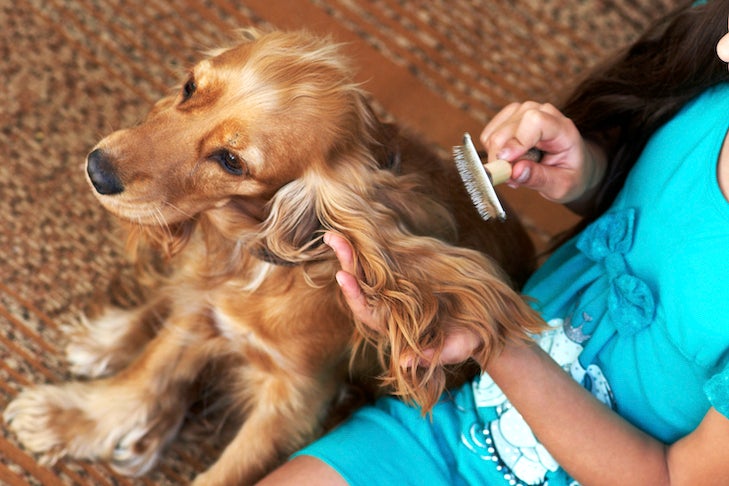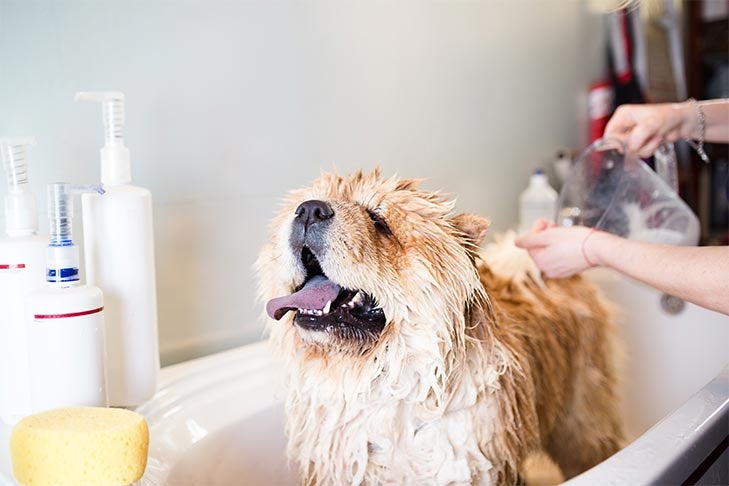Sugary tree sap can be the bane of a dog owner’s life during the spring and early summer when it flows most freely. This super-sticky substance is notoriously tricky to remove from fur. Plus, scratchy pine needles and other debris can get glued to it, turning your dog’s coat into a matted, tacky, uncomfortable mess.
Thankfully, you don’t need to avoid your daily woodland dog walks at this time of year. You’ve likely got all the tools you need to get sap out of your dog’s fur at home. And, if you act fast and come armed with treats, it doesn’t have to be a task you and your dog dread.

Why is Sap a Problem for Dogs?
It’s not just the uncomfortable matting that makes removing sap from your dog’s fur a priority. Some tree saps, like pine sap, can be mildly toxic to your pet. Sap can cause itchy hotspots, rashes, or even allergic reactions if left to linger. If your dog tries to get the sap off their paws, they can further irritate their skin or develop granulomas from excessive licking.
While sap is unlikely to cause serious problems, avoiding sap ingestion removes any risk. Depending on the tree type, licking sap can lead to stomach upset, vomiting, lethargy, drooling, or lack of appetite. If your dog displays any of these symptoms after ingesting tree sap, consult your vet.
Steps for Sap Removal
Don’t put off sap removal. The longer it sits in your dog’s fur, the more likely it is to cause irritation, tummy troubles, or messy matting. Check your dog over after every tree-lined walk, and, if you need to rid them of syrupy attachments, be ready with tons of their favorite treats or a tasty food-filled chew toy to distract and build positive associations. Here’s how to get sap out of dog fur.
1. Soften the Sap
Hard sap is problematic and painful to remove from fur—you can only cut it out in this state. If the blow dryer doesn’t horrify your dog, using it on the lowest setting can soften the sap, making it easier to separate from fur. Ensure the dryer isn’t too close or too hot for your dog’s delicate skin.
2. Apply Oil
Pet-safe oil-based lubricants are your best friend for getting sap out of dog fur. They help further soften and loosen the sticky substance. Vegetable or olive oil are the most common secret ingredients, but you can also try smooth peanut butter (your dog might try to lick it, so make sure it is xylitol and sugar-free), soft butter, or mayonnaise.
Thoroughly work a generous amount of oil into the affected fur with your fingers. If your dog is calm and patient, massaging it in for a few minutes gives it a chance to really work its magic. For dogs with sensitive skin, you could purchase a tree sap removal product specifically formulated and tested for pets.
3. Break Up the Sap
Slowly and gently work the sap out using your fingers or, better still, a wide-toothed comb. Have a paper towel on-hand to wipe up loose pieces of sap. If the sap isn’t coming off freely, don’t tug. You’ll hurt your dog, and they’ll understandably be less accommodating the next time you need to tackle this task.

Be patient, and don’t expect a large glob to slide off straight away. You might need to add more oil, especially as chunks come off in bigger pieces.
4. Pay Particular Attention to the Paws
Paws are the most frequent victims to fall foul of sap attachment. They’re also the trickiest spot to remove it from. If you’re struggling to work the oil in between fluffy toes and paw pads, try using a soft bristle toothbrush.
4. Cut Out the Stubborn Stuff
If you’ve had several oil slathering sessions and some sap doesn’t want to budge, you might need to admit defeat and cut out a small patch. Where possible, use blunt-tipped pet grooming scissors.
Be extra careful when trimming off sap stuck close to your dog’s skin. Your local groomer or vet can help if you don’t feel confident or your dog isn’t keen.
5. Give a Cleansing Bath
After all the sap is out, you still have to contend with a greasy pup. They’ll need a bath with warm water and dog shampoo to rinse out any remaining sap residue and oil. Focus your lathering efforts on the slick fur and be ready to do a couple of rinses.

What Not to Do When Getting Sap Out of Dog Fur
Steer clear of astringent solvents, chemical detergents, petroleum products, and alcohol. They’re harsh on sensitive skin, not good for your dog to lick, can irritate eyes, and won’t always break up the sap the way an oil-based substance will.
How to Prevent Sap Getting Stuck in Dog’s Fur
There isn’t a miracle solution for avoiding sap sticking to your dog’s fur. Keeping the hair around the paws trimmed short means big globs are less likely to get attached.
If you have a sap-producing tree in your yard, you could also try fencing off the area immediately around it during peak sticky season.
The post Avoid a Sticky Situation: How to Get Sap Out of Dog Fur appeared first on American Kennel Club.



0 Comments
Recommended Comments
There are no comments to display.